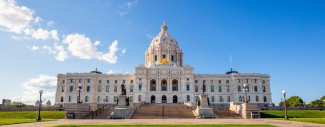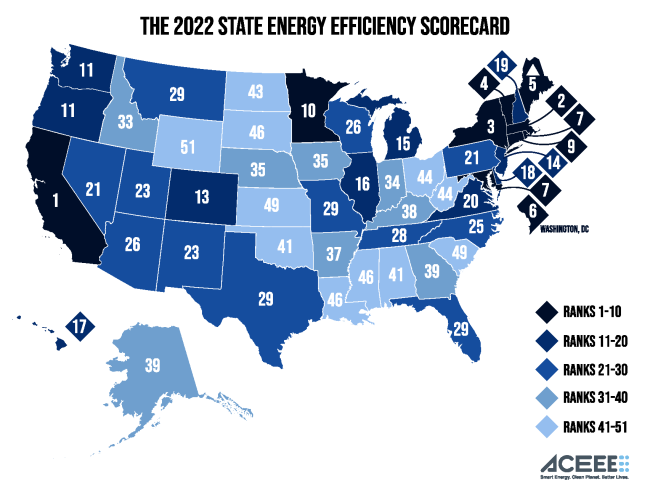California Ranks #1; Maine Is Most Improved; South Carolina and Ohio Fall Furthest
Washington, DC—As Americans struggle to pay rising energy bills, leading states have instituted energy efficiency policies that cut utility bills—especially for those who need it most—while reducing greenhouse gas emissions, according to the 2022 State Energy Efficiency Scorecard. These policies can serve as models for the dozens of states that have yet to prioritize energy-saving upgrades to reduce costs for disadvantaged households.
California comes in first place in the 50-state scorecard (which also includes Washington, DC) from the American Council for an Energy-Efficient Economy (ACEEE). California, which earned 47 of 50 points possible, centers equity in its energy policies and administers wide-reaching programs to reduce emissions from transportation, buildings, and industry. Rounding out the top 10 are Massachusetts (#2), New York (#3), Vermont (#4), Maine (#5), Washington, DC (#6), Maryland and Rhode Island (tied at #7), Connecticut (#9), and Minnesota (#10).
Regional leaders are California (#1) in the West, Massachusetts (#2) in the Northeast, Minnesota (#10) in the Midwest, Colorado (#13) in the Southwest, and Virginia (#20) in the Southeast. Each of these states has enacted sweeping clean energy laws in recent years and expanded energy efficiency efforts to achieve climate goals. The scorecard is accompanied by one-page evaluations of each state’s performance, including possible ways to improve performance.
This year’s scorecard has an expanded focus on equitable energy efficiency policies that reduce energy burdens for low-income and disadvantaged households and historically underserved communities. The report evaluates states on 12 equity-focused actions, which represent 20% of total points available. ACEEE developed the scorecard’s new equity metrics through a multi-year consultation process with community-based organizations. Thirty-four states earned less than half the points on equity, showing there is significant room for improvement.
Though most states report energy efficiency spending on low-income residents, few have more detailed metrics and ambitious goals to serve disadvantaged and hard-to-reach communities. Effective tracking mechanisms are a necessary first step for states to ensure efficiency investments are distributed equitably. California, Massachusetts, Oregon, and Washington were among the states to perform well in this area, setting examples for other states seeking to improve participation among historically underserved residents like renters, low-income households, and people with limited English language proficiency.
In another key trend, the report found that as energy efficiency programs increasingly prioritize greenhouse gas (GHG) emissions reductions, four states (California, Massachusetts, New York, and Vermont) and DC have moved to align their energy and climate goals, with fuel-neutral energy savings targets that can encourage electrification with measures like installing heat pumps. Still, at least 12 states still do not even allow utility efficiency programs to provide incentives for switching from fossil fuel heaters to efficient electric systems.
“Leading states are shifting their efficiency efforts to focus on decarbonization and reducing energy burdens for the most vulnerable residents, setting an example for other states,” said Sagarika Subramanian, senior research analyst at ACEEE and lead author of the report. “The clean energy transition will only be successful if we ensure it benefits everyone, including low-income and disadvantaged communities, while addressing historic patterns of injustice. Because of the severity of the climate crisis, even leading states must take bolder action for the United States to meet its climate targets of at least 50% GHG emissions reductions by 2030 and net-zero emissions by 2050.”
California’s top-scoring efforts included adopting rules this year to ban the sale of new cars with internal combustion engines starting in 2035 while making zero-emissions vehicles accessible to low-income and disadvantaged residents. The Golden State prioritizes equitable decarbonization of buildings by setting goals for heat pump deployment, with at least half of the heat pumps going to low-income and disadvantaged communities. The CalEnviroScreen 4.0 mapping tool identifies communities with disproportionate pollution levels, and those communities are prioritized for investments funded by California’s cap-and-trade program.
“California is proud to be recognized for our national energy leadership and is committed to continuing to advance the technologies of the future to make saving energy even easier,” said Andrew McAllister of the California Energy Commission. “Governor Gavin Newsom’s historic $54 billion budget commitment will help sustain the clean energy transition for years to come while showing that strong clean energy policy and economic prosperity go hand in hand. Placing energy efficiency at the center of the transition ensures that every Californian benefits from a cleaner and healthier environment for generations to come.”
Among other leading states, Massachusetts this year enacted a law to set energy-reporting requirements for large buildings, followed California’s lead on zero-emissions vehicles, and prioritizes investments in electric heat pumps and diversifying its energy workforce. In New York, a new law allows utilities to operate thermal energy networks as an alternative to fossil-fuel-based heating systems. New York is also investing $70 million for heat pumps in multifamily buildings. Vermont is the first state to begin phasing out mercury-containing fluorescent tube lights in favor of more efficient LEDs. Vermont’s utility-sponsored efficiency programs provide robust funding to low-income households.
Maine improved most since the last scorecard, moving up 11 spots to #5. The state set a goal to weatherize 35,000 homes and businesses and to heat at least 115,000 homes with high-efficiency electric heat pumps by 2030. State-funded affordable housing projects must be all-electric and include electric vehicle charging. Maine also adopted new appliance standards and enacted a comprehensive electric vehicle plan with equity as a key focus.
“As the most heating-oil-dependent state in the country, and with our electricity grid over-reliant on natural gas, improving energy efficiency in Maine is essential for cutting costs for Maine households while also curbing harmful carbon emissions,” said Governor Janet Mills. “This recognition by ACEEE affirms Maine’s leadership on energy efficiency, which is even more critical now given the unprecedented energy prices our region is experiencing since the Russian invasion of Ukraine. I am proud of Maine’s progress and will continue to make available programs and incentives to help Maine people reduce their energy costs and improve energy efficiency.”
South Carolina saw the steepest drop in the rankings in 2022, falling to 49th place. South Carolina lost points for allowing industrial, manufacturing, and retail commercial customers to opt out of energy efficiency programs and for restricting energy efficiency funds from incentivizing beneficial electrification. Ohio fell seven spots to 44th place. As a result of a 2019 law (HB 6) that restricted utilities’ ability to fund efficiency programs, Ohio saw a steep decline in utility-reported electric savings in 2021. Once a Midwest leader on energy efficiency, Ohio previously accounted for about 5% of the nation’s total electricity savings but is now close to 0% of national savings.
The scorecard found innovative policies to save energy and reduce emissions across states and policy areas:
- Transportation: Sixteen states and DC have adopted California’s zero-emissions vehicle program to phase out light-duty vehicles fueled by gasoline or diesel. Eight states and DC received points in the scorecard for establishing dedicated funding to install charging equipment in low-income and underserved communities.
- Buildings: Building energy codes set minimum acceptable levels of energy efficiency for new buildings. The scorecard found that seven states (California, Connecticut, Massachusetts, Montana, Oregon, Vermont, Washington) and DC have adopted the most-up-to-date commercial building codes. Connecticut and Washington updated their residential codes to maximize energy savings since the last scorecard, with five states total having adopted the most up-to-date residential code. To reduce energy use and GHG emissions from existing large buildings, Washington, Colorado, and Maryland joined DC in developing building energy performance standards, a major step forward in decarbonizing the country’s existing buildings.
- Industry: To reduce GHG emissions in the industrial sector, seven states and DC were awarded the maximum possible points in the scorecard for offering technical assistance for strategic energy management, supporting workers re-training for jobs in industrial energy efficiency, and establishing specific decarbonization targets for industry.
- State-government initiatives: Six states (California, Maine, Massachusetts, New York, Oregon, and Rhode Island) led in advancing energy efficiency across other sectors, such as setting energy-saving requirements for public buildings and fleets, setting goals to reduce energy burdens among low-income residents, and enabling inclusive participation of marginalized groups in decision-making processes.
- Appliance standards: Maryland, New Jersey, Oregon, and Washington adopted new and updated appliance standards, and New York is updating its standards. New Jersey is expected to avoid 4.5 million metric tons of carbon dioxide emissions by 2040 because of its updated standards.
The State Energy Efficiency Scorecard, now in its 15th edition, is based on data collected from state utility commissions and state energy offices as well as publicly available data. ACEEE provided state utility commissions and energy offices the opportunity to review and comment on a draft version of the scorecard prior to its publication.



